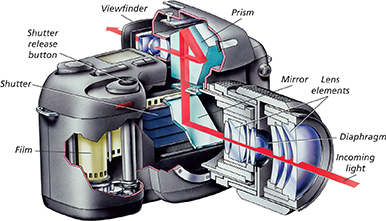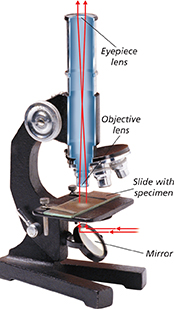Figure 14 Shown here is a typical single lens reflex (SLR) camera. The mirror reflects the image through the viewfinder so the photographer can bring it into focus. When the shutter release button is pushed, the mirror flips up. This allows the focused light rays to pass straight through the lens system and onto the film.
 d
dModern Film Camera
Figure 14 shows a typical modern film camera. The lens elements focus the incoming light rays. The focused rays then pass through the diaphragm, a device that controls the amount of light passing through the lens. When the shutter release button is pressed, the mirror flips up and the shutter briefly opens to let the focused light rays strike the film.
To bring an object into focus, the lens must be moved toward or away from the film. This focusing, which can be done manually or automatically, is needed to form a sharp image. The focused light reacts with a light-sensitive chemical coating on the film that records the real image. The image is upside down and smaller than the object. After the film is developed and printed, you have photographs for your album.
Microscopes
A microscope is an optical instrument that uses lenses to provide enlarged images of very small, near objects. One common type of microscope is called a compound microscope.  The compound microscope uses two convex lenses to magnify small objects.
The compound microscope uses two convex lenses to magnify small objects.
Figure 15 shows the structure of a compound microscope. To view an enlarged image of an object, you place the object on a glass slide. You then place the slide on a platform located above a light source. Light rays from below pass up through the object and then pass through a convex lens called the objective. The lens produces an enlarged, upside-down, real image. This image then becomes the “object” for a second convex lens called the eyepiece. The eyepiece enlarges the image. When you look through the eyepiece, you see an enlarged, virtual image of the object. Under the best conditions, modern light microscopes can magnify images more than 1000 times.
Figure 15 This compound microscope uses a mirror to reflect light up and into the microscope.
Comparing and Contrasting How is the way in which a focused image is formed the same in both a camera and a microscope?
 d
d



